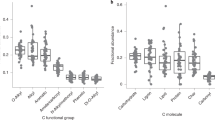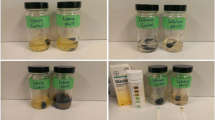Abstract
Soil organic matter is by far the most abundant form of organic matter at the Earth's surface, playing an essential role in soil fertility by maintaining a favourable soil structure, by its water-retention properties and by its ability to store and release fertilizer elements, both cationic and anionic. Yet the nature and origin of its distinctive constituents, the humic substances, remain unknown. These dark-coloured acidic unsaturated compounds are generally considered to be predominantly aromatic and phenolic in character1–3, largely on the basis of the high yields of benzene and hydroxybenzene polycarboxylic acids obtained, using various oxidation procedures, by Schnitzer et al.1. Here we present evidence, at least for the water-soluble fulvic acids, that these aromatic and associated aliphatic oxidation products are possibly, sometimes certainly, artefacts or contaminants introduced by the complex chemical procedures involved in their isolation and identification.
This is a preview of subscription content, access via your institution
Access options
Subscribe to this journal
Receive 51 print issues and online access
$199.00 per year
only $3.90 per issue
Buy this article
- Purchase on Springer Link
- Instant access to full article PDF
Prices may be subject to local taxes which are calculated during checkout
Similar content being viewed by others
References
Schnitzer, M. in Soil Organic Matter (eds Schnitzer, M. & Khan, S. U.) 1–64 (Elsevier, Amsterdam, 1978).
Hayes, M. H. B. & Swift, R. S. in The Chemistry of Soil Constituents (eds Greenland, D. J. & Hayes, M. H. B.) 180–320 (Wiley, Chichester, 1978).
Stevenson, F. J. Humus Chemistry (Wiley, New York, 1982).
Hatcher, P. G., Schnitzer, M., Dennis, L. W. & Maciel, G. E. J. Soil Sci. Soc. Am. 45, 1089–1094 (1981).
Anderson, H. A. & Russell, J. D. Nature 260, 597 (1976).
Spiteller, M. & Schnitzer, M. J. Soil Sci. 34, 525–537 (1983).
Preston, C. M. & Schnitzer, M. J. Soil Sci. Soc. Am. 48, 305–311 (1984).
Farmer, V. C. & Morrison, R. I. Scient Proc. R. Dubl. Soc. Ser. A. 1, 85–104 (1960).
Patai, S. The Chemistry of Diazonium and Diazo Groups (Wiley, New York, 1978).
Spiteller, M. Z. Pfl-Ernähr. Dung. Bodenk. 144, 500–504 (1981).
Ogner, G. Acta chem. scand. 27, 1601–1612 (1973).
Matsuda, K. & Schnitzer, M. Soil Sci. 114, 185–193 (1972).
Neyroud, J. A. & Schnitzer, M. Proc. Soil Sci. Soc. Am. 38, 907–913 (1974).
Neyroud, J. A. & Schnitzer, M. Geoderma 13, 171–188 (1975).
Schnitzer, M. & Khan, S. U. Humic Substances in the Environment (Dekker, New York, 1972).
Martin, F., Gonzalez-Vila, F. J. & Lüdeman, H. D. Z. Naturforsch. 39 c, 244–248 (1984).
Author information
Authors and Affiliations
Rights and permissions
About this article
Cite this article
Farmer, V., Pisaniello, D. Against an aromatic structure for soil fulvic acid. Nature 313, 474–475 (1985). https://doi.org/10.1038/313474a0
Received:
Accepted:
Issue Date:
DOI: https://doi.org/10.1038/313474a0
This article is cited by
-
The retention of organic matter in soils
Biogeochemistry (1988)
-
Aromaticity of soil fulvic acid
Nature (1985)
-
Aromaticity of soil fulvic acid
Nature (1985)
Comments
By submitting a comment you agree to abide by our Terms and Community Guidelines. If you find something abusive or that does not comply with our terms or guidelines please flag it as inappropriate.



